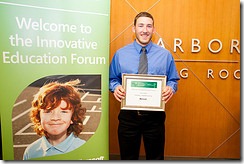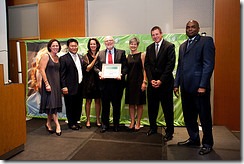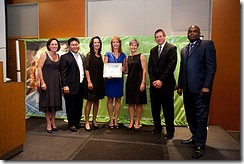Microsoft Partners in Learning 2011 U.S. Innovative Education Forum – Finalists
 On Friday evening we wrapped-up the Partners in Learning 2011 U.S. Innovative Education Forum (IEF) with the Gala Awards dinner on a fittingly stunning evening in Seattle. All 100 teachers gathered to celebrate, relax and reflect on an incredible 2+ days of project exhibitions, inspiring keynote presentations, professional learning and collaborating (you can see a few pictures on Facebook and checkout the fun video below about what participants had to say at the event). As the evening drew to a close we announced the 9 final projects and 11 educators that will go on to represent the United States at the Partners in Learning Global Forum in Washington, DC in November.
On Friday evening we wrapped-up the Partners in Learning 2011 U.S. Innovative Education Forum (IEF) with the Gala Awards dinner on a fittingly stunning evening in Seattle. All 100 teachers gathered to celebrate, relax and reflect on an incredible 2+ days of project exhibitions, inspiring keynote presentations, professional learning and collaborating (you can see a few pictures on Facebook and checkout the fun video below about what participants had to say at the event). As the evening drew to a close we announced the 9 final projects and 11 educators that will go on to represent the United States at the Partners in Learning Global Forum in Washington, DC in November.
To note, we reserved one slot based on a professional development activity we did at the event where we sent teams of educators to cultural and historical sites around Seattle which we dubbed “learning excursions.” The educators are working collaboratively on new classroom projects throughout the rest of the month and they will vote on who gets the final spot at the Global Forum (announcement to come in early September).
The projects at this year’s event came from nearly all grade levels and subjects and the finalists below were evaluated using a rigorous rubric by an esteemed panel of judges representing education and industry. It is certainly cliché to say all of the educators are winners, but each project was unique and innovative in its own way and it was personally gratifying for me to meet each one of these educators and learn more about their projects as we interacted over the past six months (see the full list of 2011 US IEF participants).
Here are the 2011 U.S. Innovative Education Forum Finalists (listed by category):
Collaboration
1st place: Colin Horak & Antonio Sablan, Franklin Pierce High School (Washington)
Project: Project Unite
This project evolved out of one 9th grader’s proposal for how to reduce the incidents of immature behavior and fighting amongst his classmates. Dubbed “Project Unite” the class came together in a broad campaign combining t-shirts, bracelets, signs and ultimately an eloquent presentation to the student body during an MLK Day assembly, followed by a moving Microsoft Photo Story presentation of the diversity within Franklin Pierce High School in Tacoma, Washington. The students continued their campaign with a series of public-service video announcements that were incorporated into the 9th grade English curriculum as prompts to promote class discussion on diversity and unity. (See a previous post I did for more info 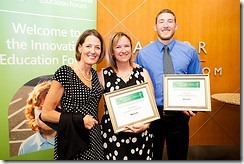 on this project)
on this project)
2nd place: Pauline Roberts, Birmingham Covington School (Michigan)
Project: Engage – BCS!
Engage is a school-wide 3rd to 8th grade program unique to Birmingham Covington School (BCS). Engage was conceived as BCS sought to reinvent itself to keep pace with the real-world skills that will be demanded of its students when they leave the school system. The overarching goal of Engage was to engage students in problem-based and project-based activities that integrated the four main elements of the enGauge 21st Century Skills: Digital Age Literacy, Inventive Thinking, Effective Communication, and High Productivity. It naturally embraces elements of science, educational technology, technology education, mathematics, and language arts.
Knowledge Building & Critical Thinking
1st place: Kelli Etheredge, St. Paul’s Episcopal School (Alabama)
Project: What’s the Verdict? The Count of Monte Cristo Murder Trial
10th grade World Literature students used a shared Microsoft OneNote notebook, Office Web Apps and Windows Live SkyDrive to share information, collaborate and prepare for a criminal trial of the character Edmond Dantès after reading the novel The Count of Monte Cristo. Students develop many 21st century skills including critical thinking, creative problem solving and collaboration to either prove or disprove the liability of Dantès. (here is a video we shot of Kelli in her classroom)
2nd place: Margaret Noble & David Stahnke, High Tech High (California)
Project: Illuminated Mathematics
Mathematics is mixed with media arts to create video, sound, photography, and mixed media installations that explore math related
topics. Students selected topics and then brainstormed creative ways of expressing their research through digital art. Each student also completed a research paper on their topic and gave a PowerPoint pre-production presentation. Student choice and in-class critiques played a critical role. (See a previous postI did for more info on this project)
Extended Learning Beyond the Classroom
1st place: Jason Arthur, Highland Tech High School (Alaska)
Project: Combat Fishin’!
Students are exposed to multiple areas of technology and mathematics, including intensive use of Microsoft Excel, graphing calculators, and PowerPoint to learn how to analyze data and make predictions about the future based on available information. The students gather data from the Alaska Department of Fish and Game and use technology and reasoning to help determine optimal fishing times and ultimately present their findings to a diverse set of members from their community.
2nd place: Nathan Manderfeld, Monroe Elementary School (California)
Project : iAM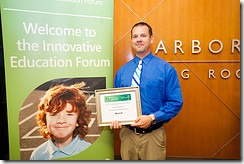
In this 4th and 5th grade project, students were exposed to careers and technology. They collaborated as they recognized the talents of their classmates and became active participants in their own learning. They did everything from becoming engineers to creating and running their own small business. They stored their work in digital portfolios with an end goal to graduate 5th grade and proudly state a possible career aspiration: “iAM an architect, iAM an engineer, iAM a graphic artist, iAM an author, iAM an entrepreneur, iAM a 21st century learner, and iAM more than a test score!”
Use of Technology for Learning
1st place: Louis Zulli Jr., Lakewood High School (Florida)
Project : Center for Advanced Technologies News and Information Portal (CATNIP)
CATNIP is an ongoing project to create a school intranet that integrates campus communication, curriculum planning and facilities management into one site with students working in collaborative teams to develop this school-wide resource. This project uses a wide variety of technologies including Microsoft SharePoint Server 2010, SharePoint Designer 2010, Visual Studio 2010, InfoPath 2010 Expression Blend, and Silverlight all led by the student’s as software developers.
2nd place: Doug Bergman, Porter-Gaud School (South Carolina) 
Project : Computer Science through Entrepreneurism and XNA Game Studio for the Xbox
Students in this hybrid computer science and entrepreneurship class learn how to manage and work on a single large computer programming project using Microsoft’s XNA Gaming Studio, as well as developing their own software coding and problem-solving skills. They apply the equally important skills of entrepreneurism using the NFTE (Network for Teaching Entrepreneurship) curriculum, building, and eventually presenting a business plan for the game idea they choose. Additionally students identify something they are personally passionate about and create a game or simulation for the Xbox that teaches, demonstrates and generates interest in the area they have chosen. (See a previous post I did for more info on this project)
Melanie Wiscount, Palmyra Area High School (Pennsylvania)
Project: History Video Podcasts & QR Codes
Students create a video podcast about an attraction, business, or organization of their choice within a 15-mile radius of their school. They research the history of their choice, plan the podcast (including media, prose and narration) develop a storyboard in Microsoft Word and then create their podcast using Microsoft Movie Maker. The students then put on their marketing hats and generate a QR code (or “tag”) for the “customers” of their chosen establishment, so people are able to access their video podcast on-demand for their PC or mobile device, while also including the podcasts in their class wiki.
You can see the press release here.
Let me know what you think? What is your favorite? Or check out all of the 2011 IEF projects and tell me who you think should be going to the Global Forum? We will continue to share more on these projects on this blog with the goal of sharing these best practices throughout the educator community. Keep in touch through our Facebook page (and be sure to “Like” it for updates) and follow me @TeachTec using #msftpil to keep tabs on these amazing educators as they go onto the Global Forum.
And to close things out, here is a fun video we shot over the 2+ days of the forum:
[View:https://www.youtube.com/watch?v=uVP7JjqIiik]
Enjoy the rest of your summer!
Rob Bayuk
U.S. Partners in Learning
(putting the “Teach” in @TeachTec)
